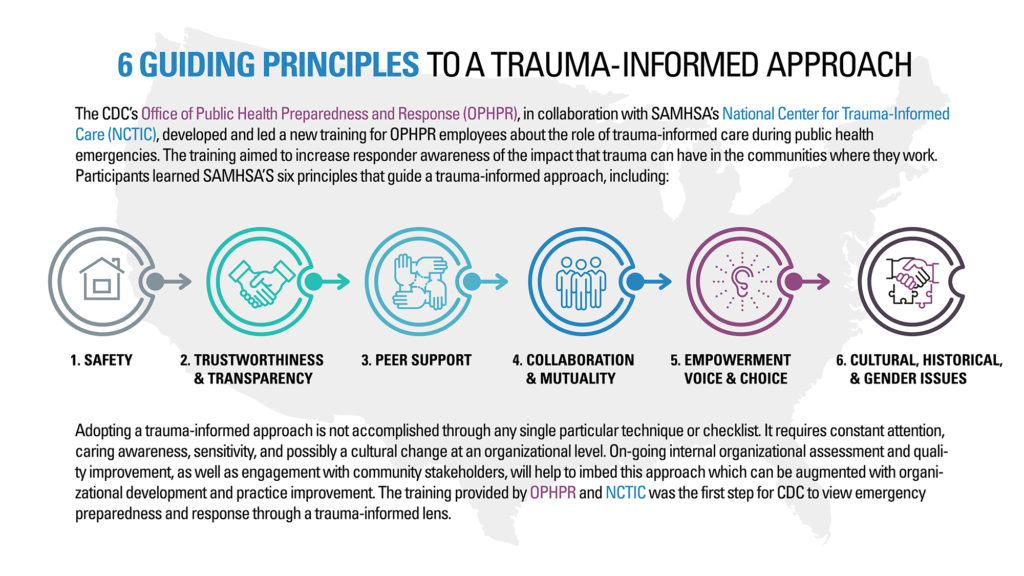When it comes to humans, there’s no shortage of trauma.
Violence, abuse, neglect, loss, disaster, war, natural disasters, pandemics, and other emotionally harmful experiences can all trigger trauma, affecting just about everyone, no matter the age, gender, socioeconomic status, race, ethnicity, sexual orientation, or geography.
According to the Substance Use and Mental Health Services Administration (SAMHSA), individual trauma results from an event, series of events, or set of circumstances that is experienced by an individual as physically or emotionally harmful or life-threatening and that has lasting adverse effects on the individual’s functioning and mental, physical, social, emotional, or spiritual well-being.
Not surprisingly, studies of people in the juvenile and criminal justice system have found a direct correlation between personal trauma and high rates of substance use disorder. While not a new phenomenon, today’s angst-filled headlines remind us that those who provide care must establish a process to treat clients facing trauma.
That’s why Averhealth encourages social service agencies, probation departments, and treatment court programs to embrace a trauma-informed approach – applying the knowledge and understanding of trauma and its far-reaching implications – to provide specific assessment, accommodation, and treatment of clients.
According to SAMHSA, a program, organization, or system that is trauma-informed “realizes the widespread impact of trauma and understands potential paths for recovery; recognizes the signs and symptoms of trauma in clients, families, staff, and others involved with the system; and responds by fully integrating knowledge about trauma into policies, procedures, and practices, and seeks to actively resist re-traumatization.”
That is often easier said than done. Public institutions and service systems that are designed to provide services and support to individuals often are themselves trauma-inducing. Take, for example, seclusion and restraints in the behavioral health system; the abrupt removal of a child from an abusing family in the child welfare system; the use of invasive procedures in medical care; the harsh disciplinary practices in educational systems; or intimidating practices in the criminal justice system.
Six Principles of Trauma-Informed Approach
Averhealth embraces the concept of a trauma-informed approach, always striving to provide care that clients view as safe, trustworthy, supportive, collaborative, empowering, and empathetic. Our team recognizes the trauma experienced by many of the clients who walk through our doors. While we do not know the specifics, we empathize with every client and strive to ensure that they experience a positive and prosocial experience.
This outlook is reflected in SAMHSA’s Six Principles of Trauma-Informed Approach:
- Safety: Staff and the people they serve should feel physically and psychologically safe in a physical setting that is safe and where interpersonal interactions promote a sense of safety.
- Trustworthiness and transparency: Operations and decisions are conducted with transparency with the goal of building and maintaining trust with clients and family members, among staff, and others involved in the organization.
- Peer support: Peer support and mutual self-help establish safety and hope, build trust, enhance collaboration, and promote recovery and healing.
- Collaboration and mutuality: An organization should recognize that everyone has a role to play in trauma-informed approach. Healing happens in relationships and in the meaningful sharing of power and decision-making.
- Empowerment, voice, and choice: Throughout the organization and among clients served, individuals’ strengths and experiences are recognized and built upon. The organization fosters a belief in the primacy of the people served, in resilience, and in the ability of individuals, organizations, and communities to heal and promote recovery from trauma.
- Cultural, historical and gender issues: The organization actively moves past cultural stereotypes and biases; offers access to gender responsive services; leverages the healing value of traditional cultural connections; incorporates policies, protocols, and processes that are responsive to the racial, ethnic, and cultural needs of individuals served; and recognizes and addresses historical trauma.
Ten implementation domains
Along with the six principles, SAMHSA outlines 10 areas, or domains, to guide an organization’s implementation of a trauma-informed approach:
- Governance and leadership: Leaders of an organization support and invest in implementing and sustaining a trauma-informed approach.
- Policy: There are written policies and protocols establishing a trauma-informed approach as an essential part of the organizational mission.
- Physical environment: The organization ensures that the physical environment promotes a sense of safety and collaboration.
- Engagement and involvement of people and family members receiving services: These groups have significant involvement, voice, and meaningful choice at all levels and in all areas of organizational functioning (e.g., program design, implementation), service delivery, quality assurance, cultural competence, access to trauma-informed peer support, workforce development, and evaluation.
- Cross-sector collaboration: Collaboration across sectors is built on a shared understanding of trauma and principles of a trauma-informed approach. While a trauma focus may not be the stated mission of organizations, understanding how awareness of trauma can help or hinder achievement of an organization’s mission is a critical aspect of building collaborations. For example, even if a clinician is trauma-informed, a referral to an insensitive program could then undermine an individual’s progress.
- Screening, assessment, and treatment: Practitioners use and are trained in interventions based on the best available empirical evidence and science, are culturally appropriate, and reflect principles of a trauma-informed approach.
- Training and workforce development: Ongoing training on trauma and peer-support are essential. The organization’s human resource system incorporates trauma-informed principles in hiring, supervision, staff evaluation; and procedures are in place to support staff with trauma history.
- Progress monitoring and quality assurance: There is ongoing assessment and monitoring of trauma-informed principle and effective use of evidence-based trauma specific screening, assessments, and treatment.
- Financing: Financing structures are designed to support a trauma-informed approach which includes resources for: staff training on trauma; development of appropriate and safe facilities; establishment of peer-support; provision of evidence-supported trauma screening, assessment, treatment, and recovery supports; and development of trauma-informed cross-agency collaborations.
- Evaluation: Measures and evaluation designs used to evaluate service or program implementation and effectiveness reflect an understanding of trauma and appropriate trauma-oriented research.
Want to learn more? Contact us for a copy of SAMHSA’s Concept of Trauma and Guidance for a Trauma-Informed Approach.



